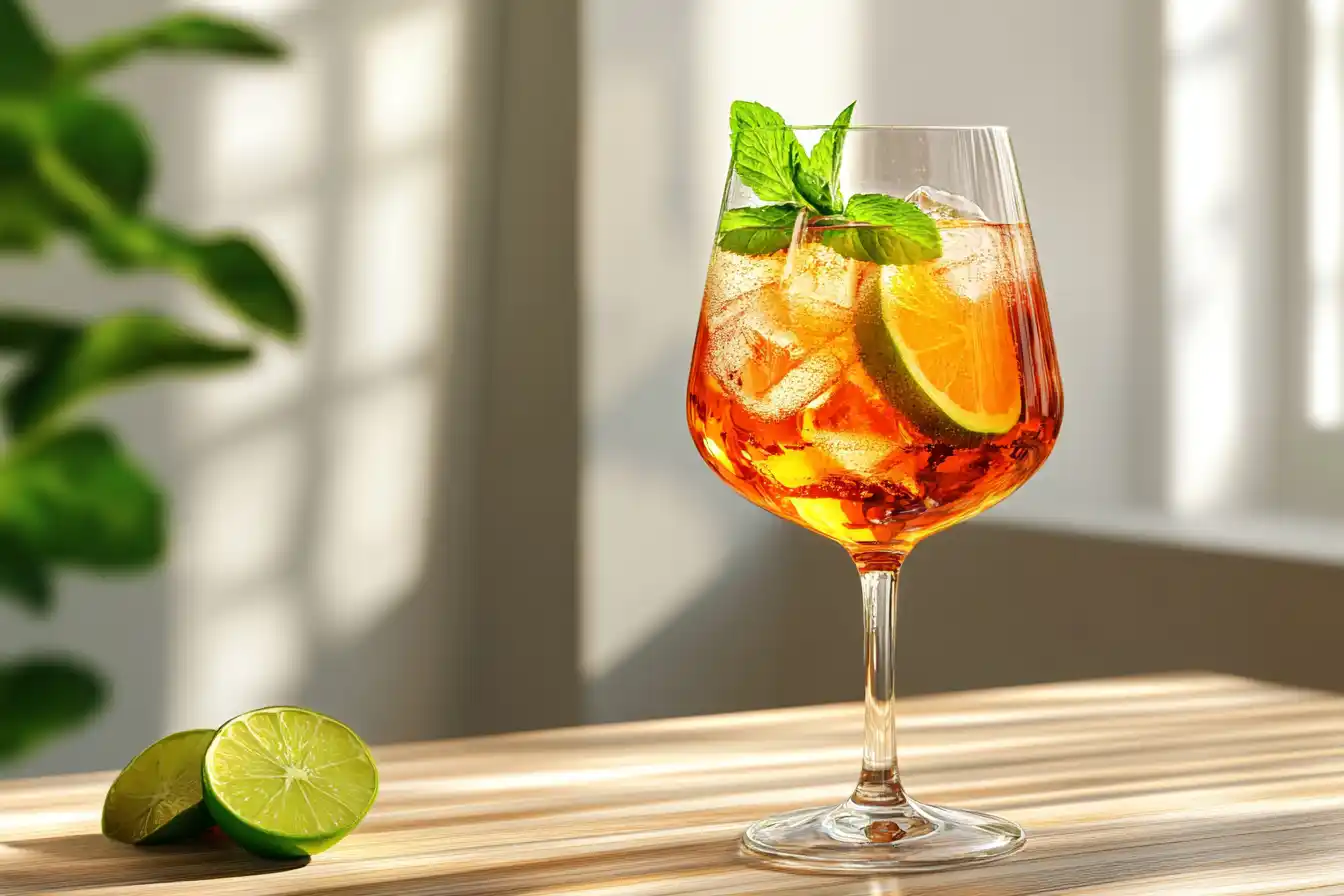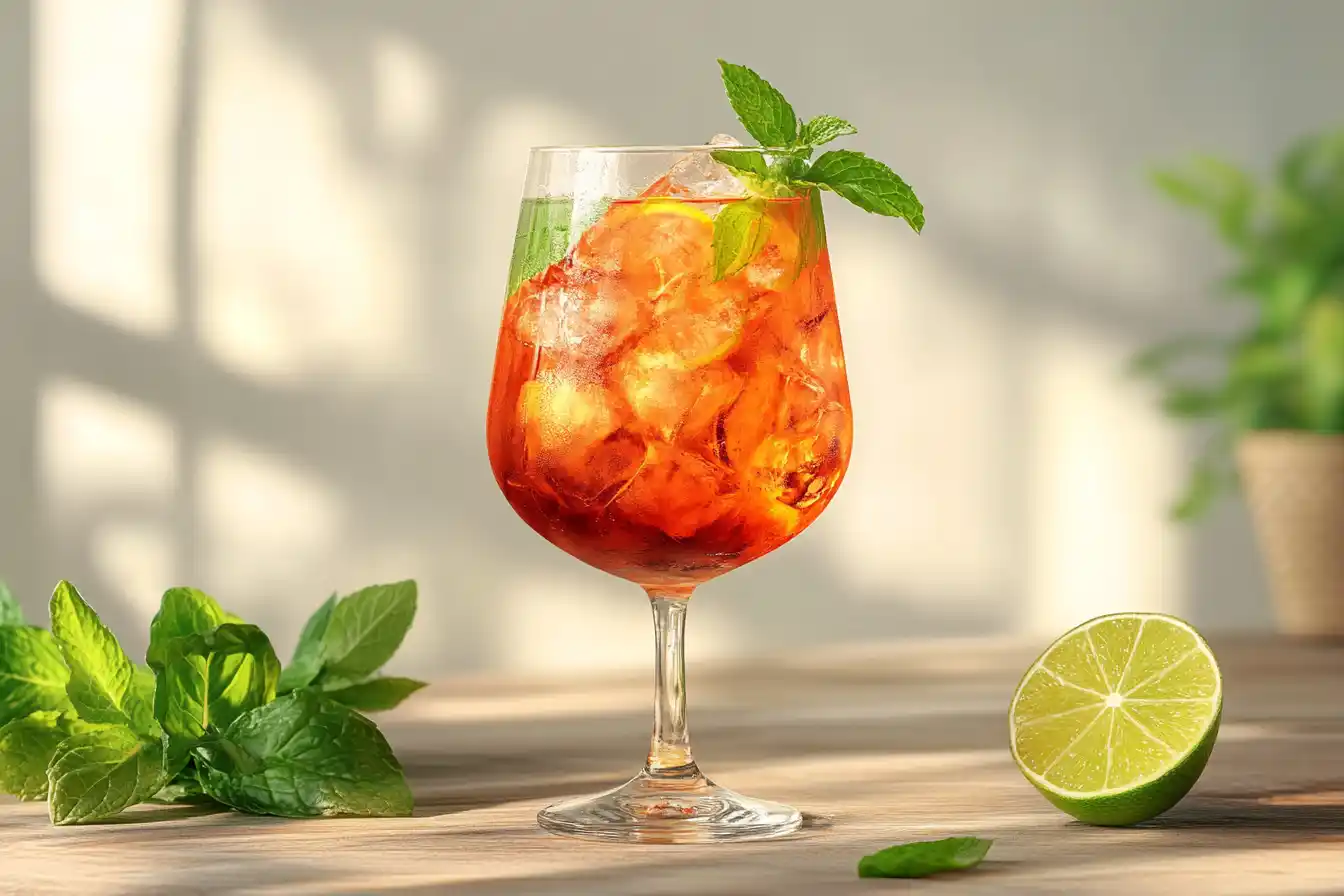Are you ready to dive into the world of refreshing cocktails? Let’s talk about one that has taken the globe by storm—Hugo Spritz! Imagine sipping on a drink that’s as light as a summer breeze but packed with flavor. That’s exactly what Hugo Spritz offers. Whether you’re hosting a dinner party or simply relaxing after a long day, this cocktail is your go-to choice.
In this ultimate guide, we’ll explore everything there is to know about Hugo Spritz. From its rich history and key ingredients to common problems and their solutions, we’ve got you covered. So grab your glass, pour yourself a drink, and let’s get started!
Table of Contents
What is Hugo Spritz?
At its core, Hugo Spritz is a sparkling cocktail that originated in Italy. Its name might sound exotic, but its components are surprisingly simple. Typically, it consists of prosecco, elderflower liqueur (such as St-Germain), soda water, fresh mint leaves, and a splash of lime juice for added zing. These elements work together harmoniously to create a drink that’s both invigorating and easy to consume.
Think of Hugo Spritz as the perfect balance between sweetness and refreshment. It’s not too strong, making it ideal for those who prefer lighter cocktails. Plus, it’s incredibly customizable, allowing you to tweak the recipe according to your preferences. Want it sweeter? Add more elderflower liqueur. Prefer it drier? Use less. It’s all up to you!
Origin and Popularity of Hugo Spritz
Now let’s journey back in time to uncover the roots of this beloved drink. Hugo Spritz first made its debut at the Alpenhaus bar in Venice, Italy, sometime around 2009. It was created by bartender Andrea Sartor as part of a promotional campaign for a new brand of elderflower liqueur. Little did he know that his creation would soon become a global phenomenon.
So why did Hugo Spritz gain so much traction? For starters, it taps into the growing trend of low-alcohol cocktails. People today are increasingly seeking drinks that allow them to socialize without feeling weighed down by heavy spirits. Additionally, its vibrant color and aromatic mint garnish make it visually appealing, which doesn’t hurt when sharing photos on social media.
As word spread about this refreshing cocktail, bars and restaurants worldwide began adding it to their menus. Today, you can find variations of Hugo Spritz almost everywhere—from high-end lounges to casual pubs. And if you’re feeling adventurous, mixing your own at home is easier than you think!
Key Ingredients in a Hugo Spritz
Before we move on to the recipe, let’s take a closer look at the star players behind this delicious drink. Each ingredient plays a crucial role in shaping the final product. Here’s a breakdown of what makes Hugo Spritz so special:
Prosecco: The Sparkling Base
Prosecco serves as the foundation of Hugo Spritz. This Italian sparkling wine brings bubbles and a subtle fruity aroma to the mix. Unlike champagne, prosecco tends to have a softer, sweeter profile, which complements the other ingredients beautifully.
When choosing prosecco for your Hugo Spritz, opt for a dry or extra-dry variety. While some people may use brut prosecco, I recommend sticking with the slightly sweeter options to enhance the overall flavor. After all, you want your base to shine through without overpowering the rest of the drink.
Aperol or Elderflower Liqueur: The Signature Flavor
This is where things get interesting. Traditional Hugo Spritz recipes call for elderflower liqueur, which imparts a floral, honey-like sweetness. Brands like St-Germain are popular choices due to their premium quality and authentic taste. However, many bartenders also experiment with Aperol, another iconic Italian liqueur known for its bitter orange notes.
If you’re torn between these two options, consider what kind of experience you’re aiming for. If you want something delicate and refined, elderflower liqueur is the way to go. On the other hand, if you prefer a bolder, citrusy kick, Aperol might be more up your alley. Don’t be afraid to try both and see which one suits your palate better.
Soda Water: The Effervescent Finish
Last but certainly not least, we have soda water. This humble yet essential ingredient adds carbonation and dilution to the cocktail, ensuring it remains light and refreshing. Always use chilled soda water to preserve its fizziness. Nothing ruins a Hugo Spritz faster than flat soda!
Some enthusiasts even swear by tonic water instead of regular soda water. Tonic introduces quinine bitterness, which can complement the sweetness of the other components. However, proceed with caution here—if you add too much, the drink could end up tasting medicinal. Stick with small amounts until you’ve mastered the balance.

How to Make a Classic Hugo Spritz
Ready to roll up your sleeves and mix your very own Hugo Spritz? Follow along with this step-by-step guide, and you’ll be sipping in no time!
Step-by-Step Guide to Mixing a Perfect Hugo Spritz
- Gather Your Ingredients : Start by collecting everything you’ll need—prosecco, elderflower liqueur (or Aperol), soda water, fresh mint leaves, lime wedges, ice cubes, and a tall glass.
- Prepare the Glass : Fill your glass halfway with ice cubes. This ensures your drink stays cold throughout consumption.
- Add Liquids : Pour approximately 50ml of prosecco followed by 20ml of elderflower liqueur (or Aperol). Stir gently to combine.
- Top It Off : Slowly pour soda water until the glass is nearly full. Leave a little room for garnishing.
- Garnish with Flair : Drop in a few sprigs of fresh mint and squeeze a lime wedge over the surface before tossing it in. Not only does this elevate the presentation, but it also enhances the aroma.
- Serve Immediately : There’s nothing worse than a lukewarm cocktail, so serve promptly while everything is still crisp and bubbly.
Tips for Customizing Your Hugo Spritz
While the classic recipe works wonders, don’t hesitate to put your personal touch on it. Here are a few ideas to inspire creativity:
- Experiment with Fruits : Add slices of cucumber, strawberries, or even kiwi for extra freshness.
- Swap Out Liquors : Replace elderflower liqueur with gin for a botanical twist.
- Adjust Ratios : Tailor the proportions based on how sweet or dry you prefer your drinks.
Stay tuned for Part 2, where we’ll discuss variations of Hugo Spritz, tackle common problems, and explore health considerations. Cheers to crafting the perfect cocktail!
Variations of Hugo Spritz
By now, you’ve got a solid understanding of the classic Hugo Spritz. But why stop there? One of the most exciting aspects of this drink is its versatility. Below are three popular variations that can take your cocktail game to the next level.
Hugo Spritz with Aperol
Let’s talk about swapping out elderflower liqueur for Aperol. While traditionalists might stick to St-Germain, Aperol brings a completely different dimension to the table. Its signature bitter-sweet flavor profile adds complexity and depth, making it an excellent choice for those who enjoy more robust drinks.
To create this variation, simply replace the elderflower liqueur with Aperol in equal measure (around 20ml). Keep the rest of the recipe intact—prosecco, soda water, mint, and lime—and voilà! You’ve got yourself a Hugo Spritz with a twist.
“Cocktail innovation isn’t about reinventing the wheel; it’s about turning the wheel in a new direction.”
This version pairs beautifully with appetizers like bruschetta or arancini, offering a perfect balance of flavors to kick off your meal.
Hugo Spritz with Gin
For gin lovers, here’s a variation worth trying. By incorporating gin into the mix, you introduce botanical notes that complement the floral essence of elderflower liqueur. Think of it as adding another layer of intrigue to an already captivating cocktail.
Here’s how you do it: Start with the base ingredients—prosecco, elderflower liqueur, and soda water—but add 25ml of your favorite gin before stirring. Garnish generously with mint and lime, just like the original recipe. The result? A Hugo Spritz that’s both refreshing and sophisticated.
If you want to elevate it further, consider using flavored gins such as cucumber or elderflower-infused varieties. These subtle nuances can transform your drink into something truly unique.
Common Problems When Making Hugo Spritz and Their Solutions
Even the best bartenders encounter hiccups from time to time. Here are some common issues people face when preparing Hugo Spritz, along with practical solutions to fix them.
Problem 1: Too Sweet
One of the biggest complaints about Hugo Spritz is that it can sometimes come across as overly sweet. If this happens, don’t panic—it’s an easy fix!
Solution: Adjust the Ratio of Ingredients
The key lies in tweaking the proportions. Reduce the amount of elderflower liqueur or Aperol slightly while increasing the soda water. For example, try using 15ml of liqueur instead of 20ml. Additionally, opt for extra-dry prosecco rather than sweeter varieties to balance things out.
Problem 2: Flat Taste
Nothing ruins a cocktail faster than a lackluster flavor. If your Hugo Spritz tastes bland or uninspired, chances are one or more components aren’t pulling their weight.
Solution: Use Fresh Ingredients and Proper Mixing Techniques
Freshness matters! Always use freshly squeezed lime juice and pluck mint leaves straight from the plant if possible. Stale ingredients can dull the overall experience. Moreover, ensure you stir the mixture gently but thoroughly to integrate all the flavors evenly.
Another tip is to chill your glass beforehand. Serving the drink in a warm glass can diminish its effervescence and impact the taste negatively.
Problem 3: Not Enough Fizz
A flat Hugo Spritz feels like betrayal. Bubbles are essential to maintaining the drink’s lightness and refreshment factor.
Solution: Ensure Cold and Fresh Soda Water
Always keep your soda water refrigerated until ready to use. Once opened, consume it promptly since carbonation dissipates quickly. Alternatively, invest in a good-quality soda stream machine to produce fizzy water on demand.
Health Considerations and Benefits of Drinking Hugo Spritz
While indulging in cocktails should always be done mindfully, the Hugo Spritz offers several advantages compared to other mixed drinks. Let’s examine why it’s considered a healthier option.
Low Alcohol Content Compared to Other Cocktails
Unlike heavy cocktails loaded with spirits, Hugo Spritz contains relatively low alcohol levels thanks to prosecco being its primary ingredient. Prosecco typically clocks in at around 11% ABV, making it gentler on the system compared to whiskey sours or margaritas.
This characteristic makes Hugo Spritz ideal for extended drinking sessions, reducing the risk of overconsumption. Plus, its light nature ensures you won’t feel weighed down after a few rounds.
Hydration Due to High Water Content
Did you know that soda water contributes significantly to hydration? Since Hugo Spritz incorporates generous amounts of sparkling water, it helps replenish fluids lost during hot summer days or physical activity. Of course, moderation is still key—you wouldn’t want to rely solely on cocktails for hydration!
Pairing Hugo Spritz with Food
One of the joys of drinking cocktails is pairing them with delicious foods that enhance their flavors. Hugo Spritz, with its light and citrusy profile, pairs beautifully with a variety of dishes. Whether you’re hosting a dinner party or enjoying a casual night in, here are some ideas to help you elevate your dining experience.
Ideal Appetizers and Snacks
When it comes to appetizers, Hugo Spritz shines alongside light, fresh, and savory options. Here are a few suggestions:
- Bruschetta : The combination of ripe tomatoes, basil, garlic, and olive oil complements the drink’s herbal undertones.
- Crostini with Ricotta and Honey : A creamy, slightly sweet spread that balances the cocktail’s effervescence.
- Caprese Salad : Fresh mozzarella, tomatoes, and basil create a perfect harmony with the mint and citrus notes in the spritz.
These appetizers not only match the flavors but also keep the meal light and refreshing, much like the drink itself.
“Food and drink should dance together, not fight for attention.”
Main Courses That Complement Hugo Spritz
While Hugo Spritz is often enjoyed as an aperitif, it can also accompany main courses that aren’t too heavy or overpowering. Consider these options:
- Grilled Seafood : Dishes like grilled shrimp, salmon, or scallops bring out the citrusy and floral elements of the cocktail.
- Pasta Primavera : A simple dish featuring seasonal vegetables and olive oil allows the spritz to take center stage without competing flavors.
- Light Risottos : Creamy yet delicate risottos, such as those made with arborio rice and parmesan, pair beautifully with the drink’s airy texture.
Avoid rich or spicy dishes, as they may clash with the subtleties of the Hugo Spritz. Instead, opt for meals that highlight freshness and simplicity.
Conclusion: Why Hugo Spritz is a Must-Try Cocktail
By now, you’ve learned everything from the history and ingredients of Hugo Spritz to troubleshooting common problems and pairing it with food. But why exactly should you give this cocktail a try?
The answer lies in its versatility and approachability. Hugo Spritz caters to both seasoned cocktail enthusiasts and beginners alike. Its customizable nature means you can tailor it to suit your preferences, whether you prefer it sweeter, drier, or even non-alcoholic. Moreover, its low alcohol content makes it an excellent choice for long evenings spent in good company.
Final Thoughts on Enjoying Your Hugo Spritz Experience
As we conclude this guide, remember that making and enjoying a Hugo Spritz isn’t just about following a recipe—it’s about creating moments. Whether you’re sipping it poolside, sharing it with friends, or experimenting with new variations, the goal is to relish the experience.
So next time you find yourself craving something light, refreshing, and flavorful, reach for the ingredients to whip up a Hugo Spritz. Trust me, once you’ve had one, it’ll become a staple in your repertoire.
“Life is short. Drink well, laugh often, and always make room for dessert—and maybe another round of spritz.”
Cheers to discovering the joy of Hugo Spritz and all the memories it brings!

